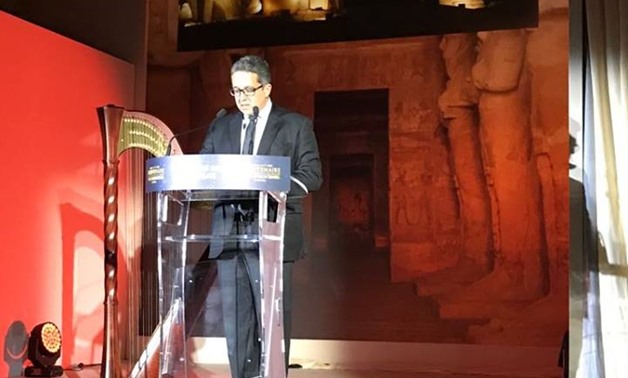
Minister of Culture Khaled El-Enany – Official Facebook Page
CAIRO – 13 September 2017: “France was an essential partner in saving the Abu Simbel temples when France’s former Minister of Culture André Malraux and Egyptologist Christian Dirouche Nu Belcor raised the awareness of the international community and UNESCO to save the Abu Simbel temples,” said Minister of Culture Khaled El-Enany during the ceremony celebrating the 200th anniversary of the discovery of the two temples of Ramses II held on Tuesday by the Egyptian embassy in Petit Palais, Paris.
The celebration was attended by many French officials, including French Defense Minister Florence Barley, ambassadors, permanent UNESCO representatives, and Egyptian candidate for UNESCO Director-General Moushira Khattab.
During the celebration, El-Enany expressed his appreciation for the Egyptian role in saving the Abu Simbel temples, in the collaboration with UNESCO, within the international campaign launched in 1962 to save Nubian antiquities.
 Bronze statues of the icons of the UNESCO campaign – Official Facebook Page
Bronze statues of the icons of the UNESCO campaign – Official Facebook Page
The Ministry of Antiquities participated in the celebration with antique reproductions of the golden wheels of Tutankhamen, statues, the model of the Abu Simbel temples and the half bronze statues of the icons of the UNESCO campaign, alongside the scientific material of the temples, added El-Enany.
 Golden wheels of Tutankhamen – Official Facebook Page
Golden wheels of Tutankhamen – Official Facebook Page
He reviewed during his speech the history of the two temples and the steps taken in the project to preserve them, inviting the attendees to visit Egypt.
Abu Simbel is the site of the two temples built by Egyptian King Ramses II to demonstrate his political clout and divine backing to ancient Nubians. On each side of the temple sits two statues of the pharaoh carved into a sandstone cliff overlooking Nile’s second cataract.
In the early 1960s, UNESCO moved the temple to higher ground, funded by more than 50 countries, when the building of the Aswan High Dam caused Lake Nasser to fill and inundate the area. The sun now strikes one day later than originally planned.

Comments
Leave a Comment